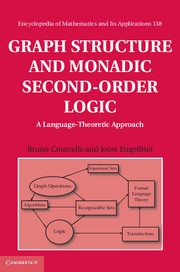Book contents
- Frontmatter
- Contents
- Foreword
- Introduction
- 1 Overview
- 2 Graph algebras and widths of graphs
- 3 Equational and recognizable sets in many-sorted algebras
- 4 Equational and recognizable sets of graphs
- 5 Monadic second-order logic
- 6 Algorithmic applications
- 7 Monadic second-order transductions
- 8 Transductions of terms and words
- 9 Relational structures
- Conclusion and open problems
- References
- Index of notation
- Index
1 - Overview
Published online by Cambridge University Press: 05 July 2012
- Frontmatter
- Contents
- Foreword
- Introduction
- 1 Overview
- 2 Graph algebras and widths of graphs
- 3 Equational and recognizable sets in many-sorted algebras
- 4 Equational and recognizable sets of graphs
- 5 Monadic second-order logic
- 6 Algorithmic applications
- 7 Monadic second-order transductions
- 8 Transductions of terms and words
- 9 Relational structures
- Conclusion and open problems
- References
- Index of notation
- Index
Summary
This chapter presents the main definitions and results of this book and their significance, with the help of a few basic examples. It is written so as to be readable independently of the other chapters. Definitions are sometimes given informally, with simplified notation, and most proofs are omitted. All definitions will be repeated with the necessary technical details in subsequent chapters.
In Section 1.1, we present the notion of equational set of an algebra by using as examples a context-free language, the set of cographs and the set of series-parallel graphs. We also introduce our algebraic definition of derivation trees.
In Section 1.2, we introduce the notion of recognizability in a concrete way, in terms of properties that can be proved or refuted, for every element of the considered algebra, by an induction on any term that defines this element. We formulate a concrete version of the Filtering Theorem saying that the intersection of an equational set and a recognizable one is equational. It follows that one can decide if a property belonging to a finite inductive set of properties is valid for every element of a given equational set. We explain the relationship between recognizability and finite automata on terms.
In Section 1.3, we show with several key examples how monadic second-order sentences can express graph properties. We recall the fundamental equivalence of monadic second-order sentences and finite automata on words and terms.
- Type
- Chapter
- Information
- Graph Structure and Monadic Second-Order LogicA Language-Theoretic Approach, pp. 16 - 79Publisher: Cambridge University PressPrint publication year: 2012

